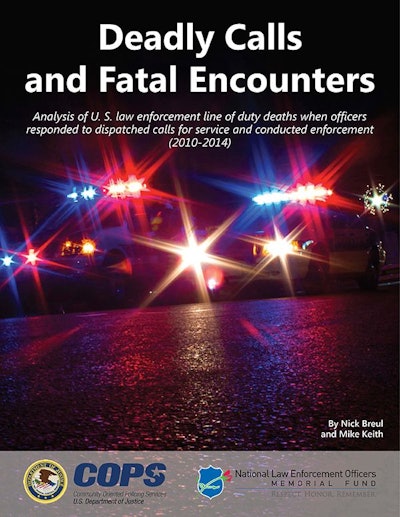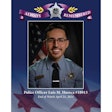 Image: NLEOMF
Image: NLEOMF
The National Law Enforcement Officers Memorial Fund (NLEOMF) has issued a new research report entitled Deadly Calls and Fatal Encounters, a five-year study (2010-2014) analyzing 684 line-of-duty deaths to identify key indicators and early trends that can impact law enforcement officer safety. The purpose of this report is to identify situations that place officers at higher levels of risk and offer multiple recommendations to enhance officer safety. This project was supported by a cooperative agreement awarded by the U.S. Department of Justice, Office of Community Oriented Policing Services (COPS).
The analysis focused on cases that involved a dispatched call for service which required a police response and what information was made available to the responding officers. Researchers also examined cases involving self-initiated actions, and what, if any, commonalities were discovered that could be utilized as learning tools to prevent future deadly calls or fatal encounters.
Key Findings Include:
- Calls related to domestic disputes and domestic-related incidents represented the highest number of fatal types of calls for service.
- More than 20% of the officers responding to calls were killed by suspects with rifles.
- A small but significant number (8%) of officers arriving first on the scene of a call took action by themselves, rather than coordinate with the backup officers they had requested or the additional units already en route.
- Sixty-three percent of officers who were killed while engaged in self-initiated action were conducting a traffic stop for vehicle enforcement.
- Fifty-three percent of fatal crashes were associated with urgent responses to Officer Needs Assistance calls or a radio request for emergency assistance from a fellow officer.
Recommendations in the Report Include:
- Greater emphasis should be placed on the need for two officers to respond to calls for service and officers should wait for the secondary unit or the backup assistance they requested before acting.
- Improve communications and information-sharing for officers on the street who are responding to calls for service. Call history, warrants, and arrest history for the location and any previously identified mental health issues should be readily available.
- Conduct dispatcher and supervisory training to better coordinate responses to high priority calls such as Officer Needs Assistance, Robbery in Progress, and Shots Fired. Ensure that domestic violence cases are monitored closely and that dispatchers challenge officers for their welfare regularly when they are on the scene of a high priority call.
- Consider training officers on passenger-side approaches during traffic stops to increase the officer's tactical advantage and reduce the likelihood of being struck by a passing vehicle.
- Given the increasing use of assault-style rifles against police, officers should incorporate the use of patrol rifles, body armor with hard armor plates, and ballistic helmets, which can be deployed during high threat responses.
"This report bears many important findings and recommendations that will help protect the men and women who serve in law enforcement. I hope that policy-makers, trainers and leaders find this information beneficial for continued development of procedures and tactics that will help improve the safety of America's law enforcement officers," said Memorial Fund President and CEO Craig W. Floyd.
A copy of the full report, "Deadly Call and Fatal Encounters: Analysis of U.S. law enforcement line-of-duty fatalities as officers responded to calls for service and engaged in self-initiated enforcement activity (2010-2014)," is available at www.LawMemorial.org/COPSReport.














